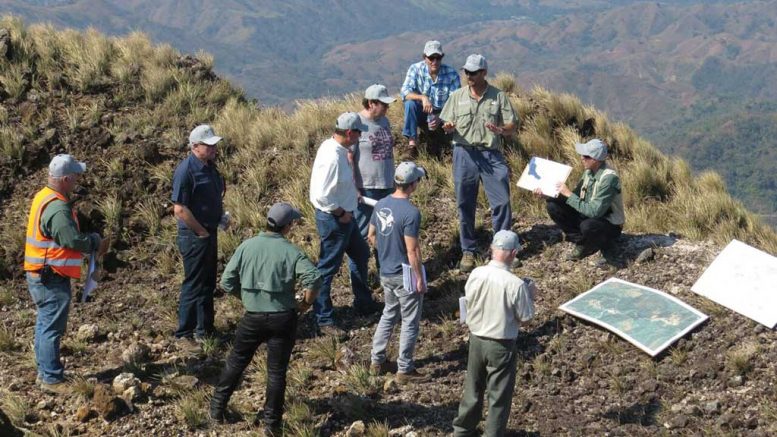Over the last month, Orla Mining (TSX: OLA) has completed two deals that help pave the way for developing its Camino Rojo gold project in Mexico’s Zacatecas state, 50 km southeast of Newmont’s (NYSE: NEM) Penasquito mine.
On March 26, the company unveiled a $75 million bought deal financing (36.6 million common shares at $2.05 per share). Newmont and Agnico Eagle Mines (TSX: AEM; NYSE: AEM) said they intend to subscribe for enough shares to maintain their current ownership positions, and Orla has also received a commitment from mine financier Pierre Lassonde.
According to the company’s most recent corporate presentation in February, Newmont holds an 18.4% stake in the company, Lassonde 12.3% and Agnico Eagle Mines 9.4%, and the three are Orla’s top shareholders.
The financing followed news on March 23 that Orla had signed a non-binding agreement with Fresnillo (LSE: FRES) to expand Camino Rojo’s proposed open pit onto part of the major’s mineral concession immediately to the north of the project.
Under the layback agreement, Orla will pay Fresnillo US$62.8 million to get the right to mine from part of Fresnillo’s mineral concession and recover all oxide and transitional material amenable to heap leaching that falls within an expanded open pit.

A worker inspects core from Orla Mining’s Camino Rojo gold project in Mexico’s Zacatecas state. Credit: Orla Mining.
“We will be in a position to optimize the oxide deposit to its full potential by including the mineralization that would not otherwise be accessible without laying back our open pit onto Fresnillo’s concession, as well as mineralization located on the Fresnillo property,” Jason Simpson, Orla’s president and CEO stated in a press release.
Andrew Mikitchook of BMO Capital Markets raised his target price on the company on April 1 from $2.25 per share to $2.50 per share and has an outperform rating on the stock. (Over the last year Orla has traded within a range of 86¢ and $2.71 and at press time was changing hands at $2.00 per share.)
“With this equity financing the company is in a position to cover both construction and the previously announced non-binding layback agreement with Fresnillo,” Mikitchook said in a research note. “Beyond the definitive layback agreement, the next catalyst should be the issuance of environmental permits to place Orla in a position to start construction in mid-2020.”

Orla Mining’s Camino Rojo gold property in Mexico. Credit: Orla Mining.
“As the coronavirus pandemic evolves there could well be impacts on the near-term timeline for Camino Rojo’s development, though there should be some leeway as Orla has ordered long lead time equipment and is not likely fully mobilizing construction until early in H2 2020.”
The layback agreement with Fresnillo will allow access to oxide and transitional heap leachable mineral resources on Orla’s property below the open pit outlined in the company’s June 2019 feasibility study. The feasibility study was based on proven and probable reserves of 44 million tonnes grading 0.73 gram gold per tonne and 4.2 grams silver per tonne out of a total measured and indicated resource of 94.6 million tonnes grading 0.71 gram gold and 12.7 grams silver that is amenable to heap leaching.
A portion of the resources amenable to heap leaching that are not in the current reserves are located just below the bottom of the pit outlined in the study and at relatively shallow depths on the north side of the pit. The layback agreement is expected to allow much of this material to be included in a revised mine plan using the same metallurgical recoveries for each rock type and similar operating costs outlined in the study.
Orla is now revising its feasibility study on a project that is unconstrained by the company’s current property boundary.
The 2019 feasibility study outlined a mine life of nearly 7 years with average annual gold production of 97,000 oz. at total by-product cash costs of US$515 per oz. and all-in sustaining costs (AISCs) of US$576 per ounce. The open pit mine would produce an average free cash flow of US$57 million per year.
Initial capex was forecast to run to US$123 million with sustaining capital of US$20 million.
The study was based on a gold price of US$1,250 per oz., and estimated a net present value after-tax of US$142 million and an internal rate of return of 28.7% for a three-year payback.
About 35% of the detailed engineering for the project has been completed and the company has started purchasing long-lead items.
Orla acquired 100% of the Camino Rojo oxide project from Newmont in November 2017 for 31.9 million common shares, representing a 19.9% stake in the company. Newmont retained a 2% net smelter return royalty on all metal production from the project, except for metals produced under a potential sulphide project joint-venture. Should a standalone sulphide project ever be developed with proven and probable reserves of at least 500 million tonnes, Newmont has the option to enter into a joint-venture, where it would own 60%. (That ownership could rise to 70% if the joint-venture used existing infrastructure at Newmont’s Penasquito mine. )
Orla has 187 million common shares outstanding for a $374-million market capitalization.
Management and directors own 3.7% of the junior.


Be the first to comment on "Orla Mining advances Camino Rojo project in Mexico"